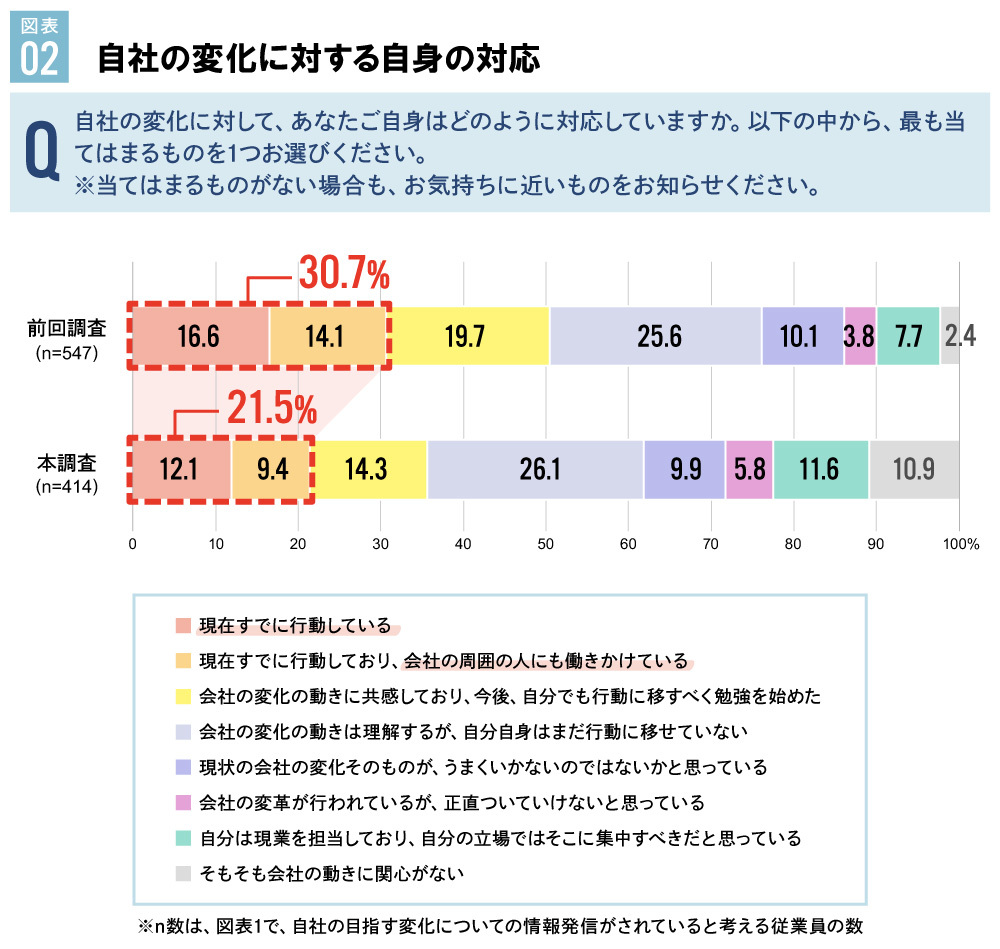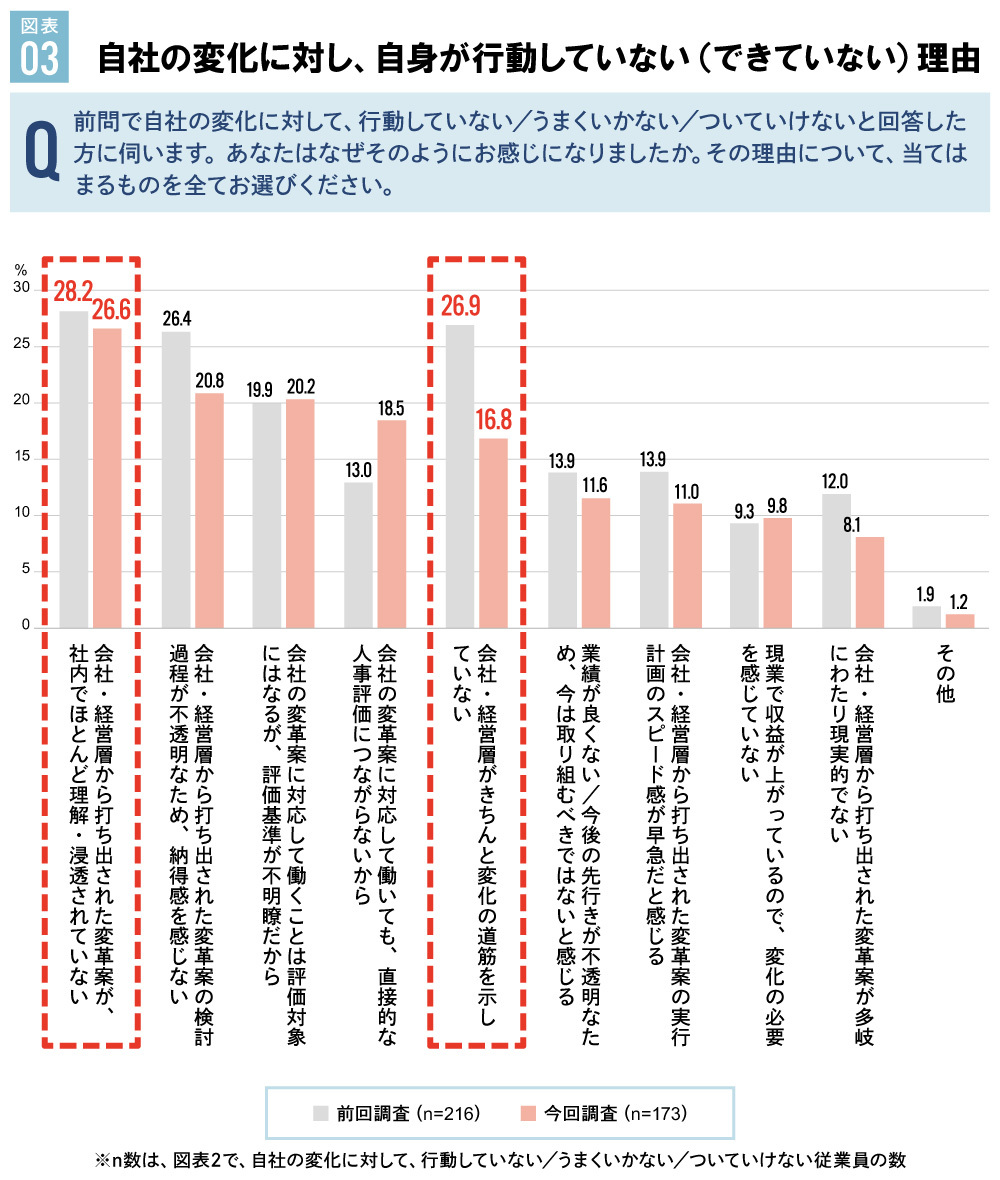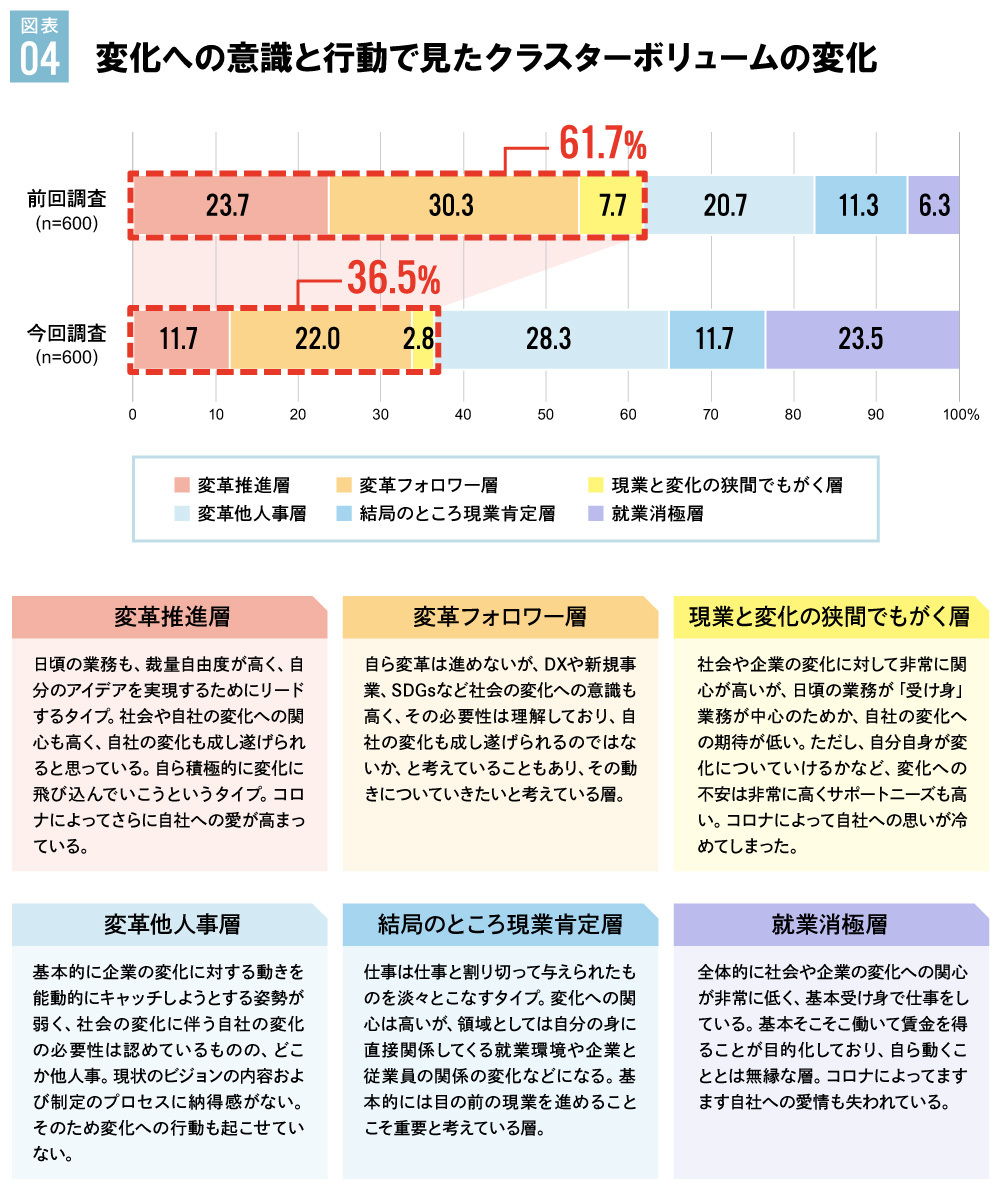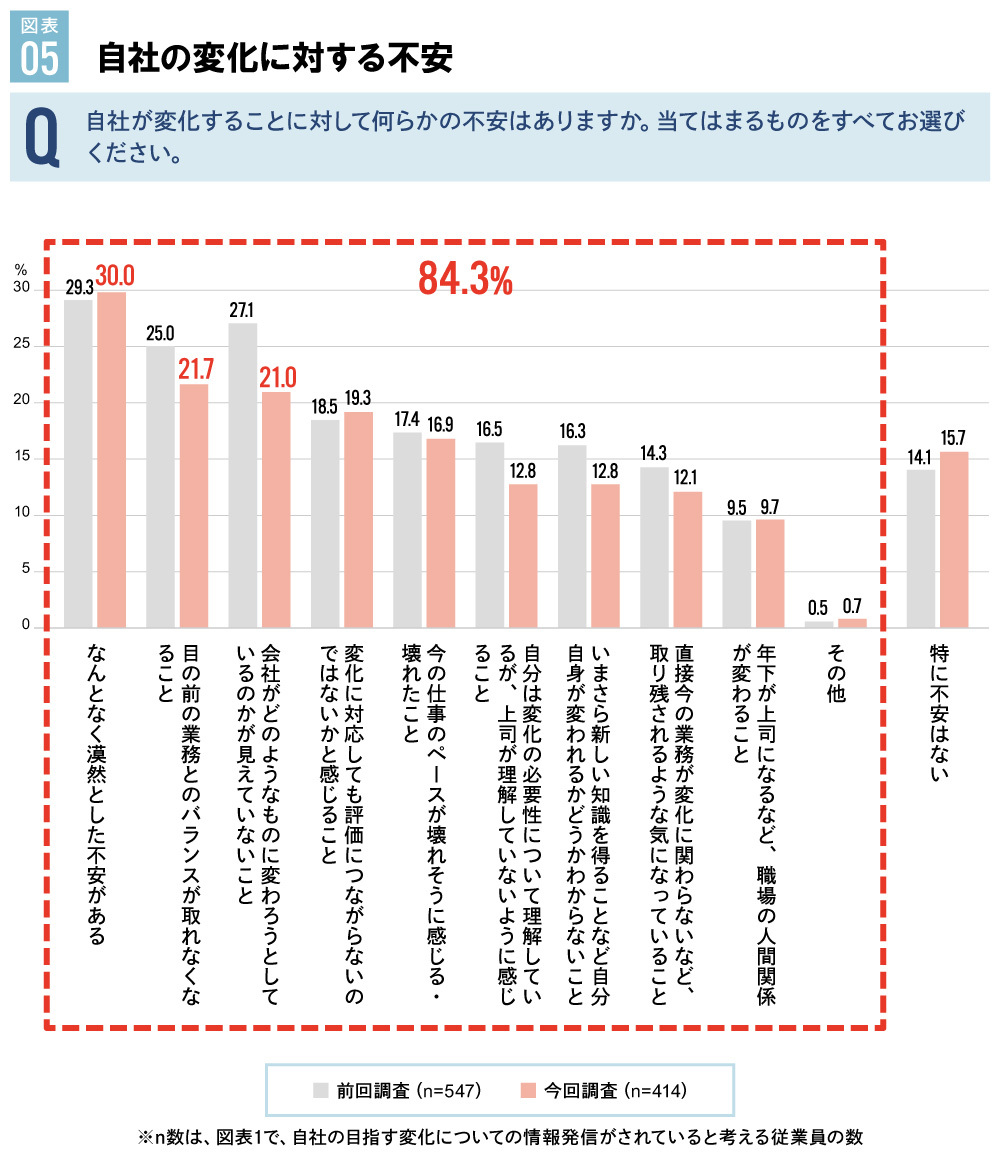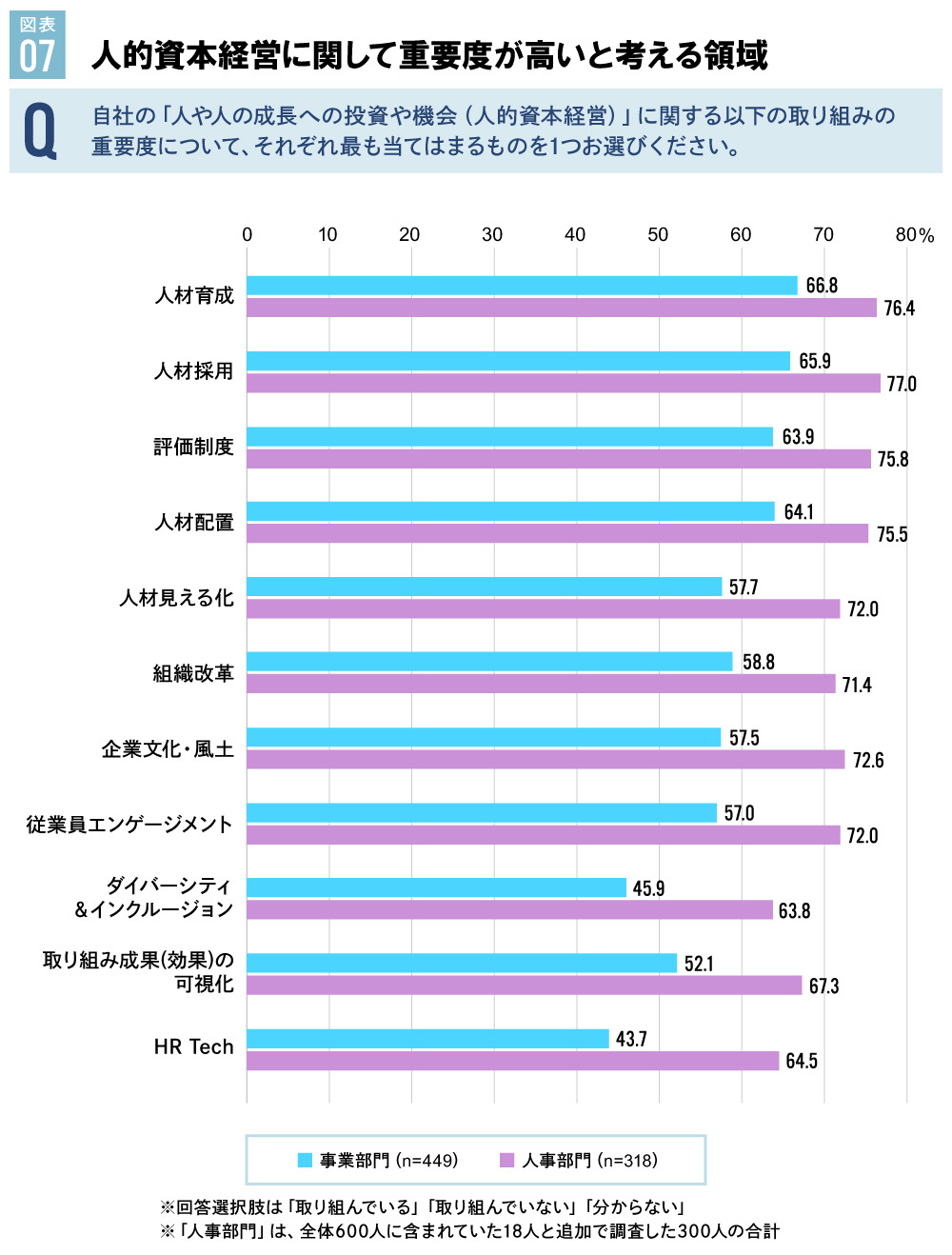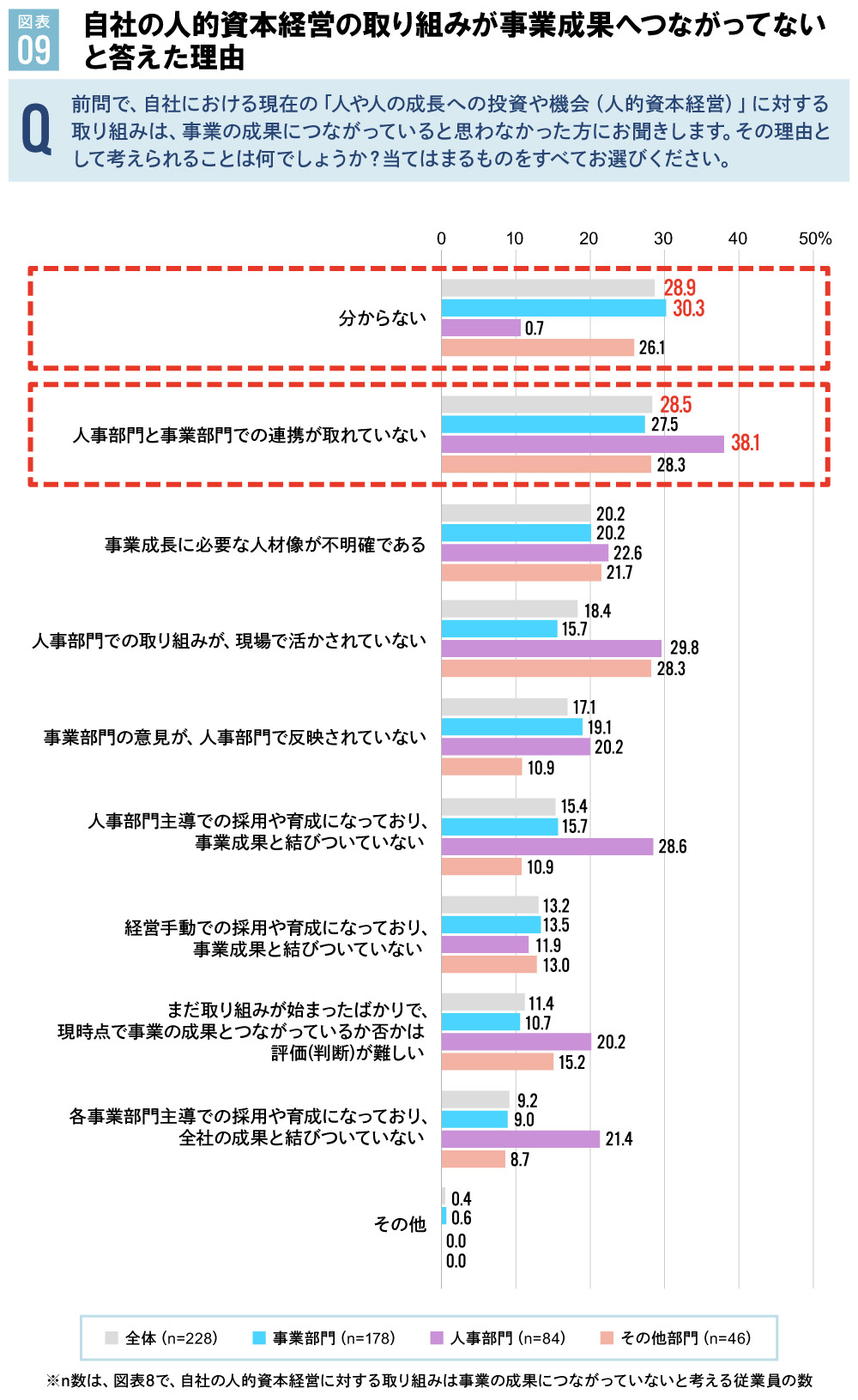When companies attempt to change, many obstacles to transformation originate internally—a situation frequently observed. This occurs because numerous employees are drawn toward various forces that affirm the status quo, such as worries and anxieties about change.
The 'HR for Growth' team, Dentsu Inc.'s support program for realizing human capital management and business growth, conducted the 'Employee Attitude Survey on Corporate Transformation ' in December 2021 and November 2023.
The first survey in 2021 targeted employees of large corporations, gauging their awareness of changes within their own companies. The 2023 survey added new questions specifically about human capital management to clarify the challenges perceived ( see survey overview here ).
The results revealed a decline in employee enthusiasm for corporate transformation and a gap in perceptions between HR and business departments.
In this article, Keiichi Yagura and Kenichiro Nagai from Dentsu Inc. BX Design Bureau, involved in "HR for Growth," analyze and explain the survey results alongside employee insights.
Are employees taking action regarding their company's transformation?
The percentage of employees who believe their company communicates about "the changes it aims to achieve" decreased by 22.2 points from the previous survey (91.2%) to 69.0%.
One reason for this decline is that some companies have reduced communications as life returns to normal post-pandemic. Another factor may be that in this era of rapid change, corporate communications about transformation have become "routine" (Figure 1).
Furthermore, the percentage of employees currently taking action regarding their company's changes decreased by 9.2 points from the previous survey (30.7%) to 21.5%, representing an overall decline of 10% in those taking action (Chart 2).
The primary reason, consistent with the previous survey, is that "the transformation plans proposed by the company/management are largely not understood or permeating within the company" (26.6%). However, "the company/management has not clearly outlined the path to change" (16.8%) decreased by 10.1 percentage points from the previous survey (26.9%) (Figure 3).
This suggests that while a broad policy direction for transformation has been presented to some extent, the lack of understanding and internalization of the specific approaches (transformation proposals) among employees is a major factor hindering action.
Proportion of Employees Driving Change Halved Since 2021
Following the previous survey, we conducted cluster analysis based on perspectives such as attitudes toward company change, thoughts/actions, and fundamental work ethic to examine how the classification of six employee types has changed.
<Six Employee Types>
Change Drivers
Change Followers
Struggling Between Routine Work and Change
Change Indifference
Ultimately Routine Work Affirmation
Passive Work Attitude
As a result, the three types showing high interest in change—"Change Drivers," "Change Followers," and "Those Struggling Between Current Operations and Change"—have significantly decreased since the previous survey. Notably, the "Change Drivers"—those who take initiative and can be considered the drivers of corporate transformation—decreased by 12.0 percentage points from 23.7% to 11.7% (Figure 4).
Reasons for this shift likely include factors similar to those cited by companies: the return to normal living conditions after the pandemic, and a sense of "change fatigue" arising from longer-than-expected delays in seeing tangible results from prolonged transformation efforts. Sustaining employee enthusiasm appears to be a critical key to successfully completing transformation.
Over 80% of employees feel "anxiety" about their company changing
This survey revealed that over 80% (84.3%) of employees feel anxious about their company's changes. The top reasons cited were: "A vague sense of unease" (30.0%), "Concerns about balancing these changes with current work responsibilities" (21.7%), and "Lack of clarity about the company's intended direction" (21.0%) (Figure 5).
Furthermore, the increase in responses citing "feeling that adapting to change won't lead to recognition" compared to the previous survey indicates that employees are not sufficiently perceiving the benefits of adapting to change themselves.
Significant Gap in Awareness Between HR and Business Departments Regarding Human Capital Management
We also examined employee perceptions regarding human capital management (investment in people and their growth opportunities) and associated challenges.
Regarding areas of human capital management such as "talent development," "talent acquisition," and "evaluation systems," the percentage of employees who believe their company is actively engaged in these areas was more than 10 percentage points higher in the HR department than in the business department across all areas (Figure 6).
Furthermore, regarding areas related to human capital management, the percentage of employees who consider it important for their company to engage in these areas was also more than 10 percentage points higher in the HR department than in the business departments for all areas except "talent development" (Figure 7), revealing a significant gap.
While the HR department has internalized these areas as their own responsibility, it is crucial to recognize that business units have not reached the same level of engagement and to proceed accordingly.
How can human capital management initiatives be linked to business outcomes?
Over half of employees (51.8%) believe human capital management initiatives are not leading to business results (Figure 8). The primary reasons cited are "Lack of collaboration between HR and business units" (38.1%) for HR, and "Don't know" (30.3%) for business units (Figure 9).
A key objective of human capital management is not only to develop HR strategies aligned with management policies but also to simultaneously address business challenges. To achieve this, HR and business units must engage in robust communication, focusing on key challenge areas, and jointly advance the necessary initiatives to generate results.
In other words, the key to linking human capital management to business outcomes lies in involving business unit members in the strategic phase to align on what is needed. Furthermore, when implementing measures for transformation, communicating with a compelling narrative to gain buy-in and encourage proactive engagement is believed to ultimately lead to business results.
Dentsu Inc. will continue to accurately capture shifts in employee mindset and develop precise countermeasures to drive corporate transformation in this rapidly changing world. If you are interested in the findings of this survey or HR strategies that drive business growth, please feel free to contact us.
【Contact for Inquiries】
Dentsu HR for Growth Team
Email: bx-project@dentsu.co.jp
【Survey Overview】
・Survey Title: Second "Employee Perception Survey on Corporate Transformation"
・Purpose: To clarify employees' awareness and perspectives regarding corporate and HR transformation within their own companies
・Target Area: Nationwide
・Respondent Criteria: Ages 20–59 (Employed at large companies※1, Manager level or below※2)
・Sample Size: 600※3 (equally distributed by gender and 10-year age brackets) + 300 HR department personnel※4 (with at least 1 year of HR experience)
・Survey Method: Online survey
・Survey Period: November 21–26, 2023
・Research Agency: Dentsu Macromill Insight, Inc.
※1: Based on the definition in the Small and Medium Enterprise Basic Act
※2: Employees whose position is "Director-level," "Manager-level," "Section Chief/Supervisor-level," "General Employee," or "Other"
※3: Equally collected from 75 individuals per gender/age group. While adding 300 HR department employees to 600 individuals aged 20–59 nationwide would yield an n of 900, sample bias occurs; thus, the overall n is 600.
※4: Targeted at those with 1+ years of HR department experience
Note: Percentage figures in this survey are rounded to the second decimal place, so totals may not add up to 100%.






